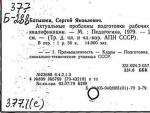What equipment is used for soldering. Tools for soldering small parts Tools for soldering
I have to solder very often, and sometimes it’s not very convenient to do it. Large parts can be clamped in a vice, but you can’t do that with small ones. There is a device for this third hand, but I didn’t want to buy such a toy in the store, I decided to make it myself from scraps at hand.
I started this creation with a stand. Cut a rectangle from centimeter plywood:

And I immediately wondered how to secure the rod to the base and then attach horizontal posts to it. Fortunately, it was necessary to cut the thread and secure it with a nut, but there was no necessary die. I had to get out of the situation...
To secure the stand at the base, I found a bolt with a longitudinal hole. It was smaller than the diameter of the rod, so I had to sharpen it a little:

To attach the horizontal posts, I found a long nut (found in Soviet cassette recorders) and machined a stock for it at the end of the rod:

I wanted to secure the nut using a threaded connection, but the drill stubbornly refused to make a hole in the end, so I had to do it this way.
The unit is ready for assembly:

To make the connection stronger, I put a tube on the rod and made a cut in it:

And he began to solder the nut:


Now we move on to securing the bolt. We clamp the part in a vice and start soldering from the top:


The part is ready:

Now what do we need to do? That's right, you need to connect the vertical post and the base. To do this, I cut out another auxiliary part - a rectangle from 4mm plywood:

Using a feather drill, I drilled a hole in the base. I also made holes in the auxiliary plywood backing and found 4 self-tapping screws. Everything is ready for assembly:


Half the job is done, the base with the vertical stand is ready. Let's move on to the second part - creating horizontal stands, clamps and a magnifying glass.
These metal plates, pins and bolts with washers are the future arms of our device:

To fasten them I use the following bolts with washers soldered to them (for ease of unscrewing/screwing):

But I took these parts out of the hard drive (magnet stand). I cut the threads with a tap and got nuts that are easy to tighten by hand:

Well, the most important thing is the clamps. I soldered bolts to the ends for fastening and rotation around the axis:

We begin to assemble the components of our mechanism.
Holder No. 1
Node details:

Assembled unit:

Holder No. 2
Node details:

Assembled unit:

Magnifying glass holder
Node details:

Soldering accessories
TO category:
Welded joints
Soldering accessories
Technological equipment for components manufactured by soldering has a number of features that must be taken into account when creating it, especially equipment used for soldering in furnaces. Typically, parts assembled for soldering are self-fixed without the use of a fixture. This is achieved both through the design of the parts and through their mechanical fastening with wire, pins, spot welding, knurling, etc.
If direct fixation and fastening of parts fails, then special devices are used, usually designed to support or compress the surfaces being joined.
Supporting devices are used when soldering parts, the relative position of which is ensured by the presence of seats pre-provided in their design. One of such devices is shown in Fig. 2.

Rice. 1. Device for roller welding of longitudinal seams on shells of small diameter
Compressing devices not only support the parts assembled for soldering, but also press them against each other with a certain force. The design of such devices is determined by the shape and properties of the materials of the product being soldered, as well as the soldering method.
Depending on the soldering temperature and the requirements for soldered products, various methods of pressing parts are used: using springs, threaded elements, wedges, pneumatic or vacuum, using the difference in the linear expansion coefficients of the material of individual elements of the device.
A compression device with a spring clamp is shown in Fig. 3. The performance of such a device depends mainly on the soldering temperature and the properties of the spring material at this temperature.
In Fig. Figure 4 shows a diagram of a thermal clamping device, where the clamping force is created due to the difference in the linear expansion coefficients of individual elements of the device, made of dissimilar materials.
When soldering with local heating, the structural elements of the device, if possible, must be removed from the heating zone in order to eliminate heat losses due to heating of the device and to prevent its warping.
In conditions of general heating soldering, the fixtures must withstand a sufficiently large number of repeated thermal cycles. This places certain demands on their design and the materials from which they are made. In addition to maintaining the immobility of parts during the soldering process, the design of the device should ensure easy removal of soldered assemblies and prevent them from warping.
To avoid jamming of soldered parts in a fixture, it is necessary to strive to minimize the contact surface of the parts of the soldered assembly with the fixture. When soldering with general heating, threaded fastening of parts is not recommended; it should be replaced with wedges, spacers, weights, etc.

Rice. 2. Fixing device for soldering parts with general heating: 1 - parts to be soldered, 2 - device
When soldering in a circulating protective atmosphere, the devices must prevent the formation of air pockets.
When designing a device, the possibility of warping should be taken into account. The degree of warping depends on the selected material of the device, its design, the nature of the heating and the soldering temperature.
For example, you should not use holes in a relatively thick plate as a centering base, which itself can be greatly deformed when heated. A more rational solution would be to insert free-fitting replaceable liners into these holes with an internal centering hole, which can be used as a base. For group soldering, multi-position devices are more convenient to use than individual ones. However, this is limited by the size of the oven and the weight of the device itself in the assembly.

Rice. 3. A device with a spring clamp for soldering with fusible solders: 1 - parts to be soldered, 2 - spring. 3 - pressure screw

Rice. 4. Device with thermal clamp: 1 - soldered parts, 2 - aluminum cylinder. 3 - steel glass, 4 - cork
The materials of devices for soldering with general heating are subject to a number of specific requirements:
1. The ability to withstand repeated heating to soldering temperature without warping or reducing physical and mechanical properties.
2. Good machinability in order to obtain a given accuracy.
3. Sufficient hardness and wear resistance to allow frequent assembly and disassembly.
4. The possibility of using means to prevent unnecessary wetting of the surface with solders during the soldering process.
5. Their coefficient of linear expansion must correspond to the coefficient of linear expansion of the parts of the soldered assembly.
Based on these conditions, various materials are used for soldering fixtures: structural and stainless steels, heat-resistant alloys, refractory metals. In addition to metals and alloys, in some cases ceramic materials are used, which are very resistant to soldering temperatures in any atmosphere. In addition, ceramic materials do not oxidize, resist abrasion well and do not warp at high heating temperatures. The disadvantages of such materials are the difficulty of mechanical processing and their tendency to crack under repeated thermal loading. Therefore, they are most often used in devices in the form of simple parts - cylinders, weights, stands, etc.

Rice. 5. Diagrams of devices for soldering with general heating: 1 - parts to be soldered, 2 - plate, 3 - screw, 4 - wedge, 5 - liner
Soldering fixtures must be monitored frequently. The design of such devices must allow repair and restoration of the required dimensions and replacement of individual parts.
When soldering in furnaces, special containers are often used in which the soldered products are placed. Containers for these purposes can be:
a) rigid, fully loaded into the oven;
b) rigid with a rubber seal of the water-cooled flange, which is in the process of soldering outside the working space of the furnace;
c) soft, also completely loaded into the oven.
Rigid containers can be sealed with backfill or sealed with an airtight seal. The requirements for the rigidity of the container structure are determined by the operating conditions. So, if soldering is carried out in a vacuum, then the container must be designed for the required external pressure at a given heating temperature.
The design of containers often includes special elements for pressing the soldered parts. For this purpose, in rigid containers, pneumatic cushions are sometimes used in the form of a welded envelope made of low-carbon or stainless steel with a sheet thickness of 0.6 - 1.0 mm. To create a clamping force, air or nitrogen is supplied to it under the required excess pressure.

Rice. 6. Schemes of containers for soldering: a - a container sealed by backfill, b - a container sealed by welding, c - a rigid container with a pneumatic cushion, d - a rigid container with a rubber lid seal (only the hot zone of the container is loaded into the oven), e - soft container, 1 - container, 2 - container lid, 3, 4 - pipelines, 5 - sealing fill, 6 - parts, 7 - pneumatic cushion, 8 - heat shield
When soldering in a vacuum, the pressure can be achieved by the container itself. For this purpose, soft thin-sheet containers are used (sheet thickness 0.6 - 1.0 mm). When a vacuum is created inside the container, the parts are pressed due to the difference between internal and external pressures. When soldering parts of complex shapes, the container is made according to the shape of the parts. In order to increase the clamping force, a combined method of creating pressure is sometimes used. In this case, a soft container containing the product with an internal vacuum is placed in another hard container, inside of which excess pressure is created. Various steels are used for containers: low-carbon, stainless and heat-resistant. When developing equipment for soldering, in order to increase the economic effect of its use, it is necessary to strive for the possibility of its repeated use.
Today I want to tell you about how you can make a device yourself that will help you ease the soldering process...
Watch the video of the soldering fixture:
Problems often arise when you need to solder wires or something else and don’t have enough hands. You need to hold the soldering iron with one hand, hold the workpiece that needs to be soldered with the other hand, and you also need another hand to hold the other end of the wire that needs to be soldered. Another problem arises when, in addition to these listed “three hands,” you also need a fourth one, which will hold the magnifying glass (for especially small details). After analyzing this problem, I came to the conclusion that it can be solved with the help of a homemade device, which will be discussed today.
Let's start with the first problem: "the third hand is the holder"
For our entire design we will need small wooden beam. We take two wooden clothespins and use self-tapping screws to screw them to our beam as shown in the photo:


We do not clamp the screws too tightly so that we can change the inclination of the clothespins.

We have solved the first problem. The “third hand” for soldering is ready!

Second problem: where to put a hot soldering iron so as not to spoil the work surface?
Wire. We bend it as shown in the photo:

Next, we make two small holes on the side of our wooden beam that match the diameter of the wire and insert the ends of the wire into these holes in the beam. We end up with a design like this, on which you can safely place a hot soldering iron:

The design is also good because it can be folded and thereby save space when storing this device:

The third problem: where to put the solder and rosin?
To solve this problem we need a small metal lid from a jar. We make a hole in it and fix it on top of the beam using a self-tapping screw:

Fourth problem: When soldering particularly small parts, a problem arises when you need to look at the soldering process very closely. To do this we need a magnifying glass and a two-core wire.

We take the wire and tightly wrap our magnifying glass as shown in the photo:

The edge of the magnifying glass should fit exactly between the two wire strands (this will allow the magnifying glass to hold very well). Next, twist the ends of the wire, thereby securing the magnifying glass:

Now we need a “dog” from under the wooden latch, which we screw into the wooden beam using self-tapping screws.








 Why do you dream of being a beggar?
Why do you dream of being a beggar? Read the book “Pastel Magic” online Read Pastel Magic
Read the book “Pastel Magic” online Read Pastel Magic Prophet's Church on Porokhov
Prophet's Church on Porokhov Toasts with garlic from black bread: recipe
Toasts with garlic from black bread: recipe